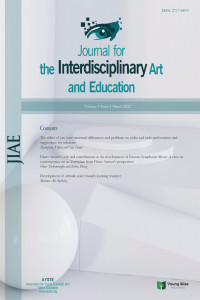The anatomical analysis of basic stance in ballet
The anatomical analysis of basic stance in ballet
Ballet anatomy, ballet education,
___
- Clippinger, K. (2007). Dance Anatomy and Kinesiology. Champaign, Human Kinetics
- Edel Quin, S. R. (2015). Safe Dance Practice. Champaign, Human Kinetics
- Faller, A., & Schünke, M. (2012). Der Körper des Menschen. Leipzig, Georg Thieme Verlag
- Franklin, E. (2004). Kraftvoller Auftritt. Augsburg: VAK Verlag GmbH
- Frege, J. (2018). Kreativer Kindertanz. Leipzig, Henschel Verlag
- Haas, J. G. (2010). Dance Anatomie. München, Copress Verlag
- Kugler, P. (2021). Der menschliche Körper Anatomie Physiologie Pathologie. München, Elsevier GmbH
- Simmel, L. (2009). Tanzmedizin in der Praxis. Leipzig, Henschel Verlag
- Vural, Z. T. (1994). Bale ve Anatomi (Sanatta yeterlilik tezi, İstanbul Üniversitesi, İstanbul). Erişim adresi Ulusal Tez Merkezi.
- WEB REFERENCES Foley, L. (2014, 10 June). Alignment: A Trip Around The Torso. Dance Advantage. Access Address: https://www.danceadvantage.net/alignment-refresher/
- Kay, P. L. (2010, 26 January). Break Your Bad Habits: The Shoulders. Dance Magazine. Access Address: https://www.dancemagazine.com/break-your-bad-habits-the-shoulders-2306863273.html
- FIGURE REFERENCES a- The dancer executes the demiplié with proper turn-out in the hips, b- The dancer executes the same move compensating improper turn-out of the hips by greater flexion of the knees, (2021, 10 December). Access Address: https://www.scienceofmotion.com/documents/the_meaning_of_life.html
- a- The ideal spine, b- Excessive spinal curvature and posture disorder caused by cervical lordosis, c- Excessive spinal curvature and posture disorder caused by lumbar lordosis, Profesyonel Bale
- Dansçılarında Aşırı Kullanımından Kaynaklanan Sakatlıklar ve Nedenleri, Sanem Subaygil, p. 89.
- Correct placement of head, (2021, 10 December). Access Address: https://ballethub.com/ballet-technique-tip/keep-chin-level-easier-spotting/
- Correct standing, Dance Medicine in Practice, Liana Simmel, p.48
- Function of ball and socket joint, (2021, 10 December). Access Address: https://www.slideshare.net/nassarayoub/types-of-joints-82716221
- Inversion and eversion, (2021, 10 December). Access Address: http://www.tedavihareketleri.com/ayak-bilegi-burkulmasi
- The five basic positions of ballet, (2021, 10 December). Access Address: https://www.atimetodance2015.com/printouts.html
- The foot skeleton from three sides, Dance Medicine in Practie, Liana Simmel, p. 124
- Weight distribution, (2021, 10 December). Access Address: https://cbphysicaltherapy.com/toe-box-wide-enough-simple-test-ensure-running-success/
- Yayın Aralığı: Yılda 4 Sayı
- Başlangıç: 2020
- Yayıncı: Genç Bilge Yayıncılık
Reflections on the direction of the theatre after the experience of the Corona Pandemic.
The “strange affinities”: early Chinese American Vaudevillians’ blackface performance
The anatomical analysis of basic stance in ballet
Seda AYVAZOĞLU, Gökben Feda DÜNDAR
